What are hardware and what are they?
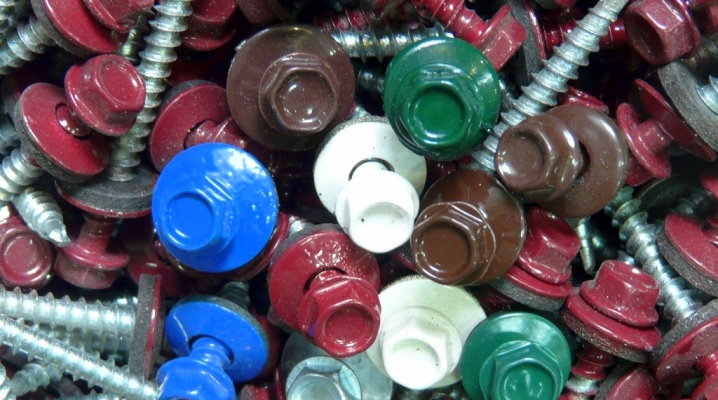
Despite the record prevalence of various types of fasteners, the answer to the question of what hardware is and what they are is still relevant. Such products have been widely used in everyday life for many decades, as well as in many areas and industries. More than a wide range of hardware for various purposes is presented in the corresponding market segment.
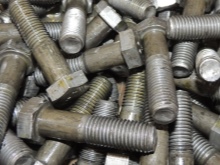
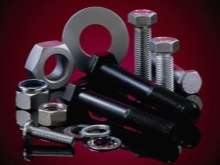
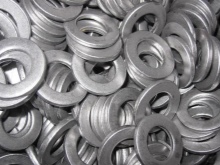
What it is?
Answering this question, one should initially determine the meaning of the term itself, which, by the way, has no foreign analogues and does not relate to metallurgy. The appearance of the word "hardware" was the result of a desire to replace the long name with a shortened one. As a result, from the "metal products" turned out to be the same "hardware".
We have to deal with a wide variety of hardware products all the time. Fasteners are an integral part of repair, construction and locksmith work. It should be borne in mind that the range of metal products is not limited solely to fasteners.
The category of hardware, taking into account their characteristics, includes products not only for household but also for industrial purposes. Based on the definition, it can include any products made of metal, as well as products of the 4th redistribution in metallurgy. In practice, most often we are talking about small-sized devices used in the installation of various structures.

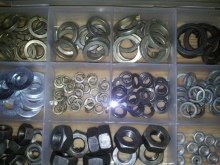

At the household level, the term under consideration means metric fasteners. Foreign and domestic manufacturers offer a wide range of similar products. At the same time, the list of the most common hardware includes:
- nails and cotter pins;
- bolts, nuts, washers and screws;
- ordinary screws and self-tapping screws;
- rivets of various types;
- hairpins;
- dowels and anchors;
- electrode and wire;
- hinges and various fasteners in the form of brackets.
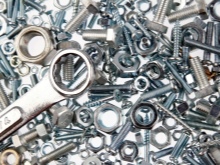
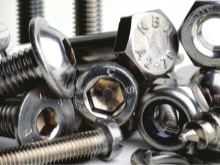
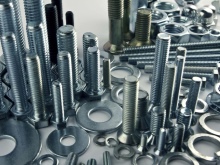
All listed products find application almost everywhere and have no alternative... They are relevant in situations where a high-quality and most reliable connection of different elements is required. It should be noted that the automotive industry employs about 4.5 thousand fastening positions.
Hardware is indispensable in furniture production when creating cabinet models. However, the main consumer of the described products today remains the construction industry. In everyday life, it is presented in the form of inventory, consumables for minor repairs, as well as office supplies. In this case, one of the main characteristics of most samples is the possibility of repeated use.
The properties and performance of all fasteners are clearly regulated by the relevant standards. This also applies to labeling. So, general-purpose fasteners are usually designated "ГЗ", and this category includes the following varieties:
- ГЗ1 - bolts of all types;
- ГЗ2 - screws and studs;
- ГЗ3 - nuts of all configurations;
- ГЗ4 - rivets (pull and threaded);
- ГЗ6 - cotter pins and washers;
- ГЗ7 - pins.
The eighth class (GZ8) includes all other metal products, mainly for industrial use.
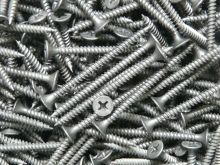

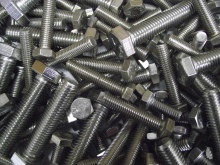
Classification
First of all, it should be noted that currently available fastening hardware can be divided into 2 main groups. One of them includes models with threads of certain sizes (up to inches and more), which are called metric fasteners.... In this case, we are talking about bolts, nuts, washers and studs.
The second category of metal fasteners includes fixtures of different appearance and configuration. The list of products includes screws, including countersunk samples, self-tapping screws, nails and many other hardware. In this case, it is important to take into account that each group of products is designed to perform specific tasks.
Taking into account a number of nuances and technical characteristics, it is recommended to use them only for their intended purpose.
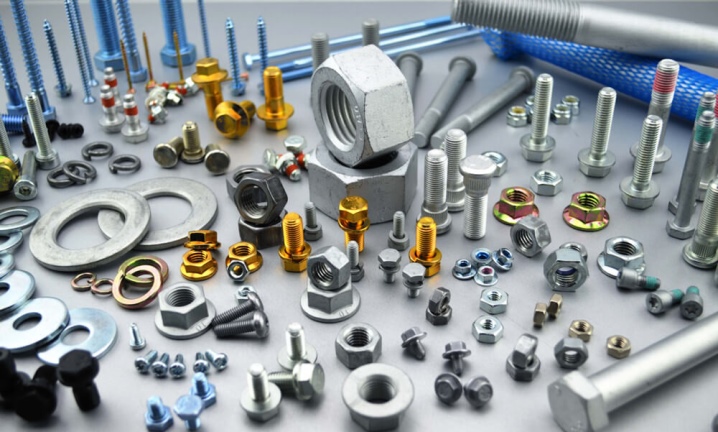
By appointment
Taking into account the rather wide range of products on the domestic market, there is a wide selection of hardware, which differ from each other in their purpose. Fasteners can be divided into 2 broad categories based on size and performance.
- For domestic use. Despite their relatively small size, such hardware is widely used in almost all areas of modern life. They are indispensable when performing repair work, in small-scale construction and a whole list of other everyday situations. And we are talking, among other things, about a variety of stationery related to the described metal products.
- Designed for the industrial sector. Representatives of this group of fasteners are widely used in mechanical engineering and many other industries. Their list includes, for example, rivets, pins, cotter pins, railway crutches, various wire products and much more.
Taking into account all of the above, we can conclude that hardware includes not only the most common and well-known to all such fasteners as bolts, nuts, screws and screws. We are talking about more than a wide range of high-strength products that can withstand various loads.
The unique performance properties of hardware determine a wide scope of their application.

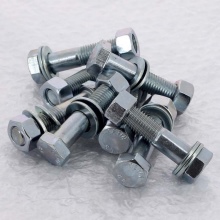
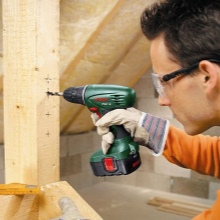
Based on materials
Initially, it should be noted that metals in their pure form are used extremely rarely for the production of products. Most often, various alloys, which include several elements, act as raw materials. The most common option is steel, that is, an alloy of iron and carbon. There are quite a few similar compounds, but in this case, only the materials from which the hardware is made are worthy of attention, namely:
- structural carbon steel;
- spring steel;
- malleable cast iron;
- stainless steel;
- copper;
- brass;
- bronze;
- aluminum alloys.
There is a range of galvanized products on the market, as well as made of stainless steel. At the same time, hardware made from spring steel deserves special attention. These include washers, split pins, rings of various diameters and configurations, and other fasteners. In their manufacture, a structural alloy with an increased carbon concentration (0.5-07%) is used as a raw material.
As a rule, such compounds contain silicon and manganese.
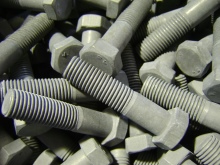
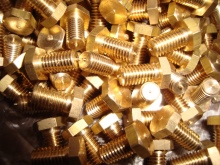

Considering more than a wide range of applications for metal fasteners manufacturers offer in their market segment samples of products made not only of steel. A whole niche is occupied by aluminum products. In addition, non-ferrous metals can be easily found on sale. For example, models made of copper are presented:
- rivets (pull and driven);
- sealing rings;
- nuts according to DIN 934;
- small wallpaper and decorative nails;
- washers.
Among other things, brass hardware is available on the market in the form of bolts, screws, self-tapping screws, cotter pins, washers, as well as individual structural elements of anchors.
Manufacturers also paid attention to bronze, from which, for example, rivets and spring washers are now made.
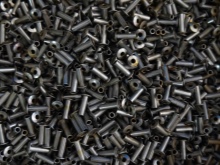
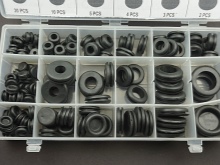

By strength class
All basic technical requirements for fasteners are enshrined in the relevant official standards. So, for example, standards for threaded hardware are set out in GOST 1759.0-87... In this case, we are talking about the mechanical properties of materials, including coatings, markings, symbols and even packaging. In this case, one of the key points is strength.
In accordance with the current standards and requirements for screws, studs and bolts made of alloyed and unalloyed carbon steels, there are 11 strength classes. Each of them is denoted by two numbers separated by a dot. In this case, the first must be multiplied by 100, and the result is the minimum tensile strength, measured in N / sq. mm. At the same time, the product of these two numbers, increased by a factor of 10, gives the material flow rate. For example, grade 4.8 is characterized by material strength and fluidity of 400 and 320 N / sq. mm respectively.

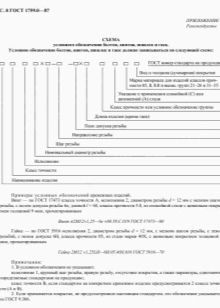
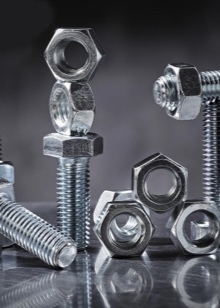
Selection Tips
Many characteristics of the mounted structures and units directly depend on the correct selection of hardware. By the way, it doesn't matter if you need fasteners for metal, drywall, or wood or plastic work. Based on this, it is highly recommended that special attention be paid to a number of key points.
- Each group of products under consideration has your specific purpose, and should be used appropriately.
- All performance indicators directly depend on the type and quality of materials. All modern manufacturers produce products that must fully comply with current standards. Certificates will help to verify this.
- Each metal product has specific dimensions and characteristics. Such a classification helps to eliminate possible confusion when choosing. All key parameters of fasteners are determined taking into account the characteristics of the parts to be connected and the requirements for structures.
- An equally important criterion is potential life of hardware.
- For many, the manufacturer plays a key role, as well as the financial side of the issue. The latter is relevant when performing large volumes of work related to the purchase of an appropriate number of products.
In addition to all of the above, attention is often paid to appearance.
In parallel, the surface of the hardware is checked for chips, cracks and other defects.
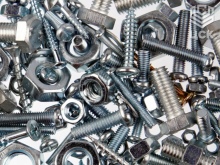
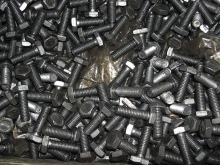
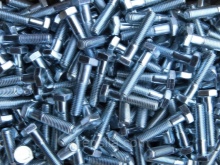
Features of operation
All the nuances of using metal products are determined by the scope of their application. It is worth analyzing the technical features of the installation processes taking into account the characteristics of a particular type of hardware.
- Nails - one of the most common options for fasteners. They are most often used when working with soft materials.
- Bolts are one of the easiest to use types of devices. For their installation, no threading is required, but it is enough only to drill a hole, since they fix the parts in tandem with the nuts.
- Screws They are distinguished primarily by the presence of a cylindrical thread, as well as the ability to reliably connect different materials.
- Self-tapping screws today they represent one of the most popular groups of modern hardware. Versatility is one of their main advantages. By cutting the threads in the materials to be fixed, the most rigid and high-quality connection is obtained.
- Wood screws - these are fasteners that are often confused with self-tapping screws. In this case, the main difference is that the former do not cut the threads themselves in the fastened parts during installation. Quite often, screws are used when working with plastic.
- For secure twisting and fixing, they are installed washers and rings. These hardware are placed under the heads of bolts or nuts to prevent loosening of the connections during the operation of structures and units.
- Hairpins have double-sided threads and are relevant in appropriate situations. Automotive hubs and wheel mounts are prime examples of this.
- Anchor plates very often used when installing window structures, which with their help are fixed in openings.
Naturally, this is not a complete list of existing hardware and features of their operation. And also it should be borne in mind that some of them are part of larger fasteners. These are, for example, anchors consisting of a dowel, a washer, as well as a bolt or screw.

See below for more details.













The comment was sent successfully.